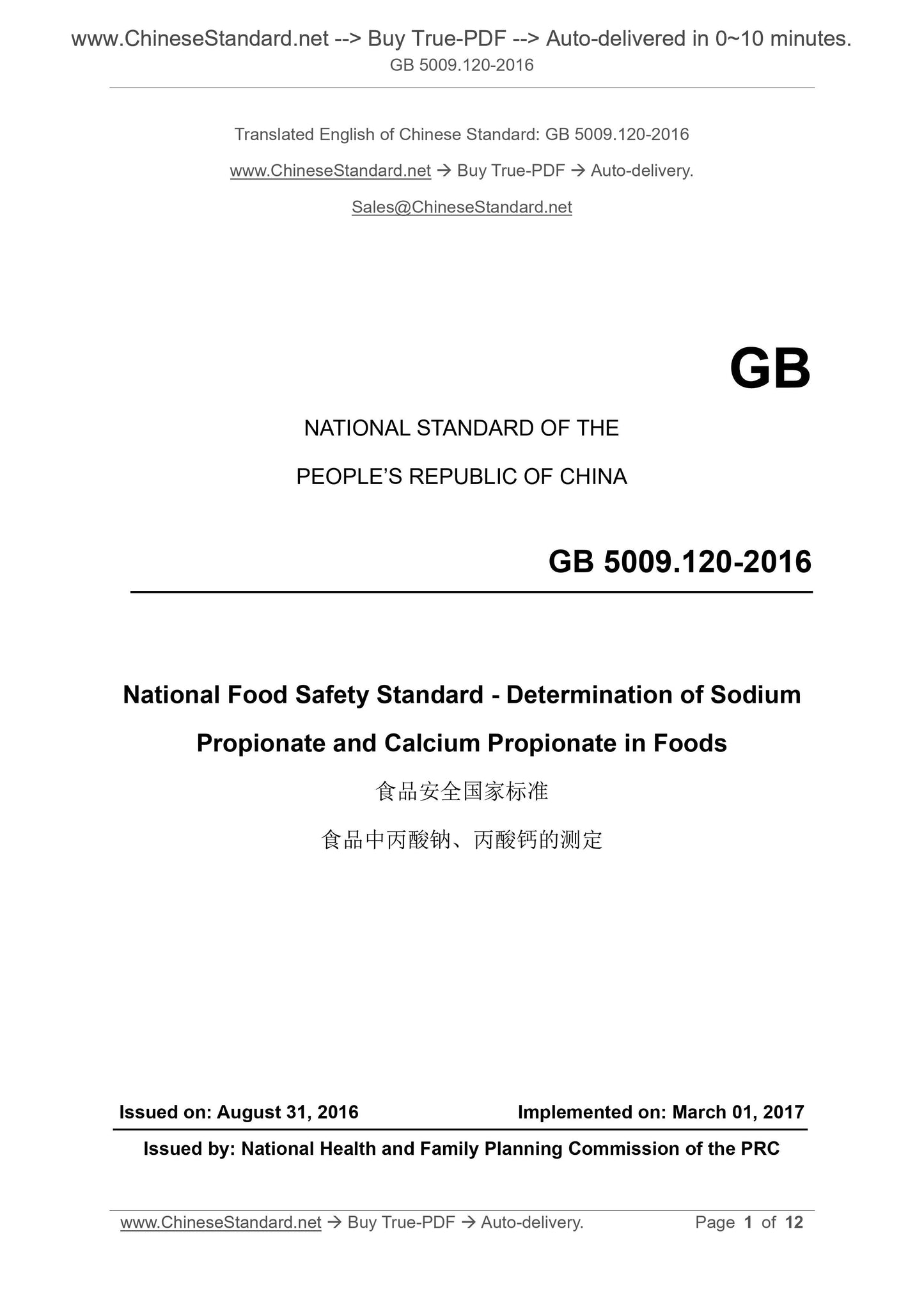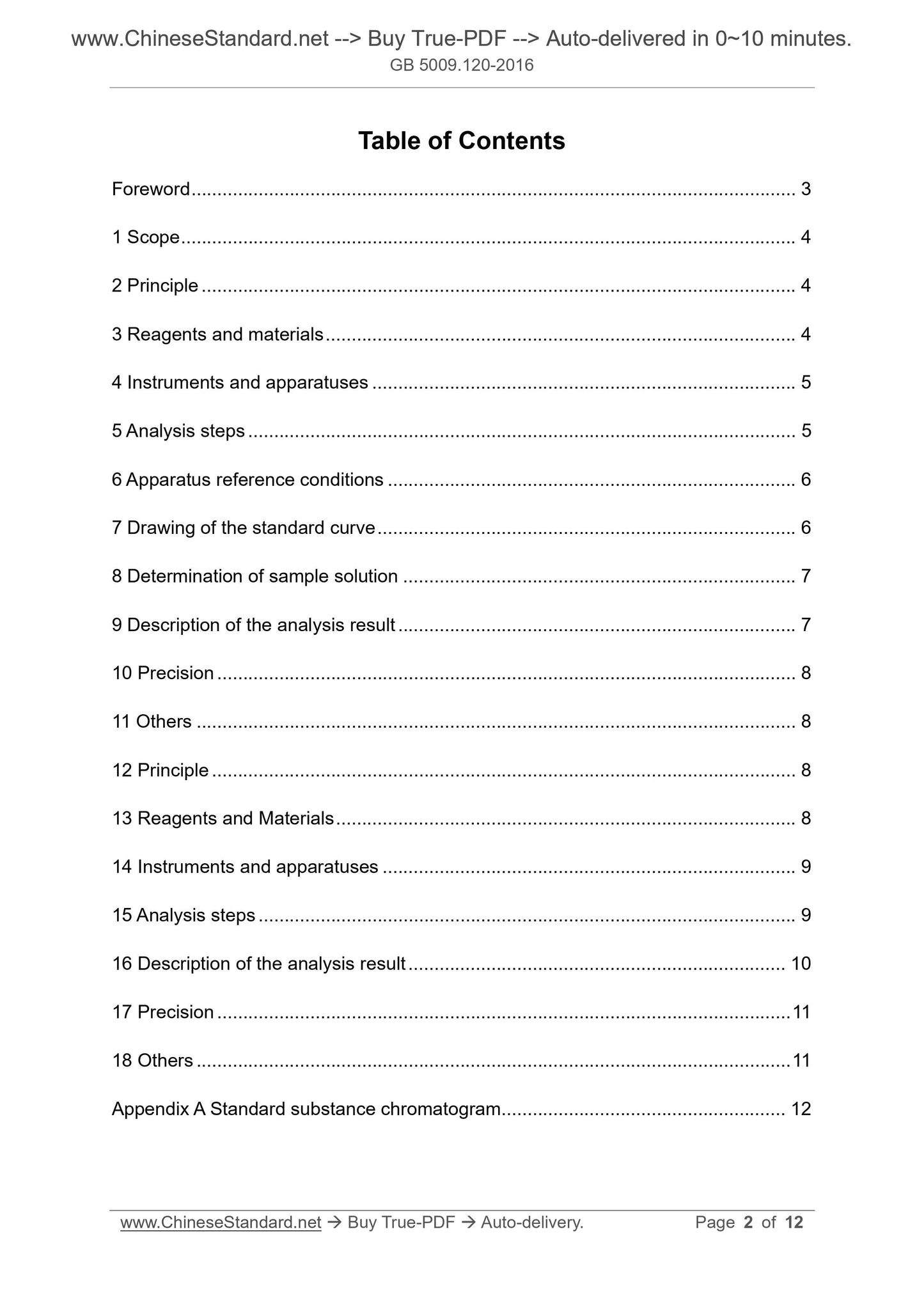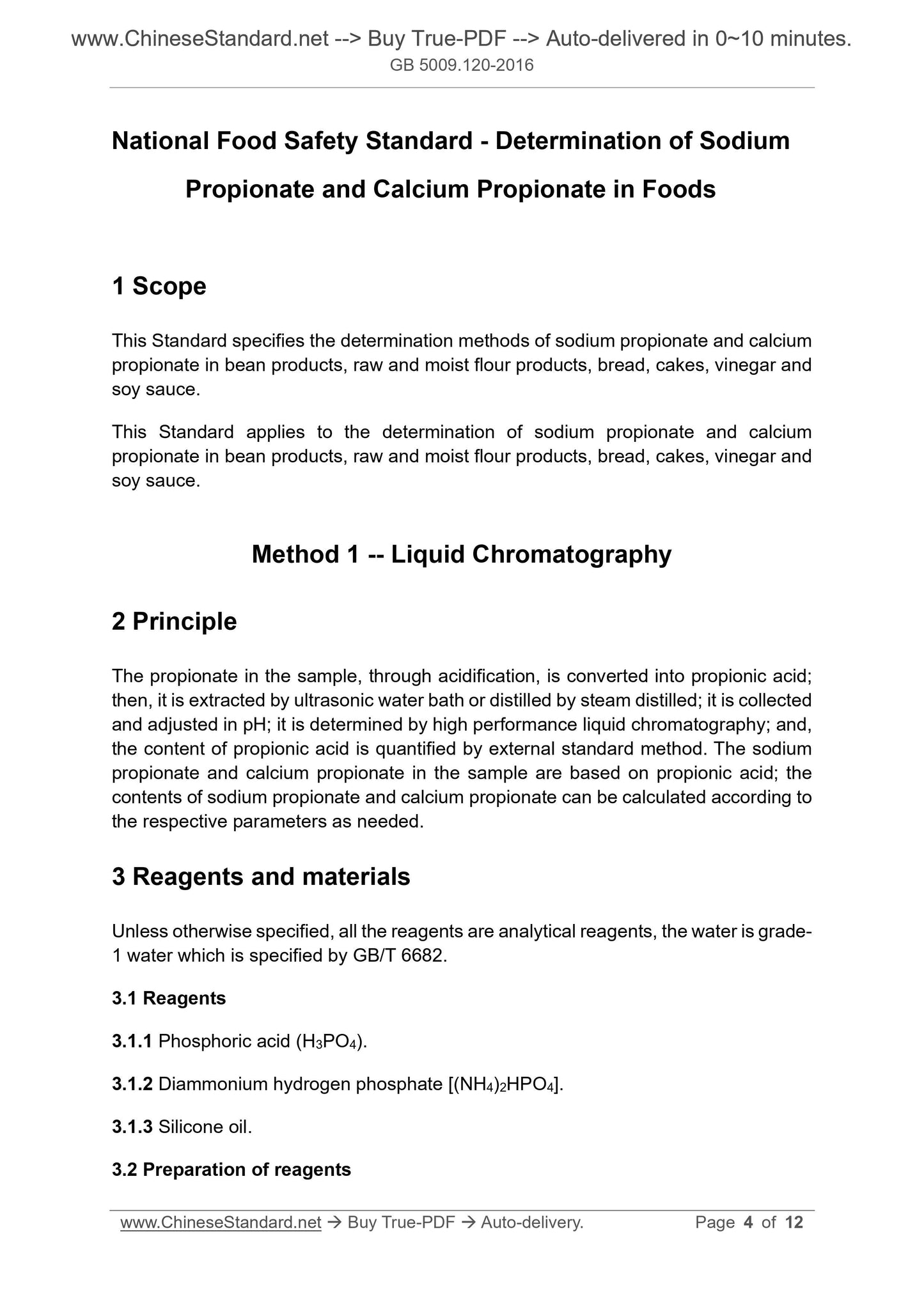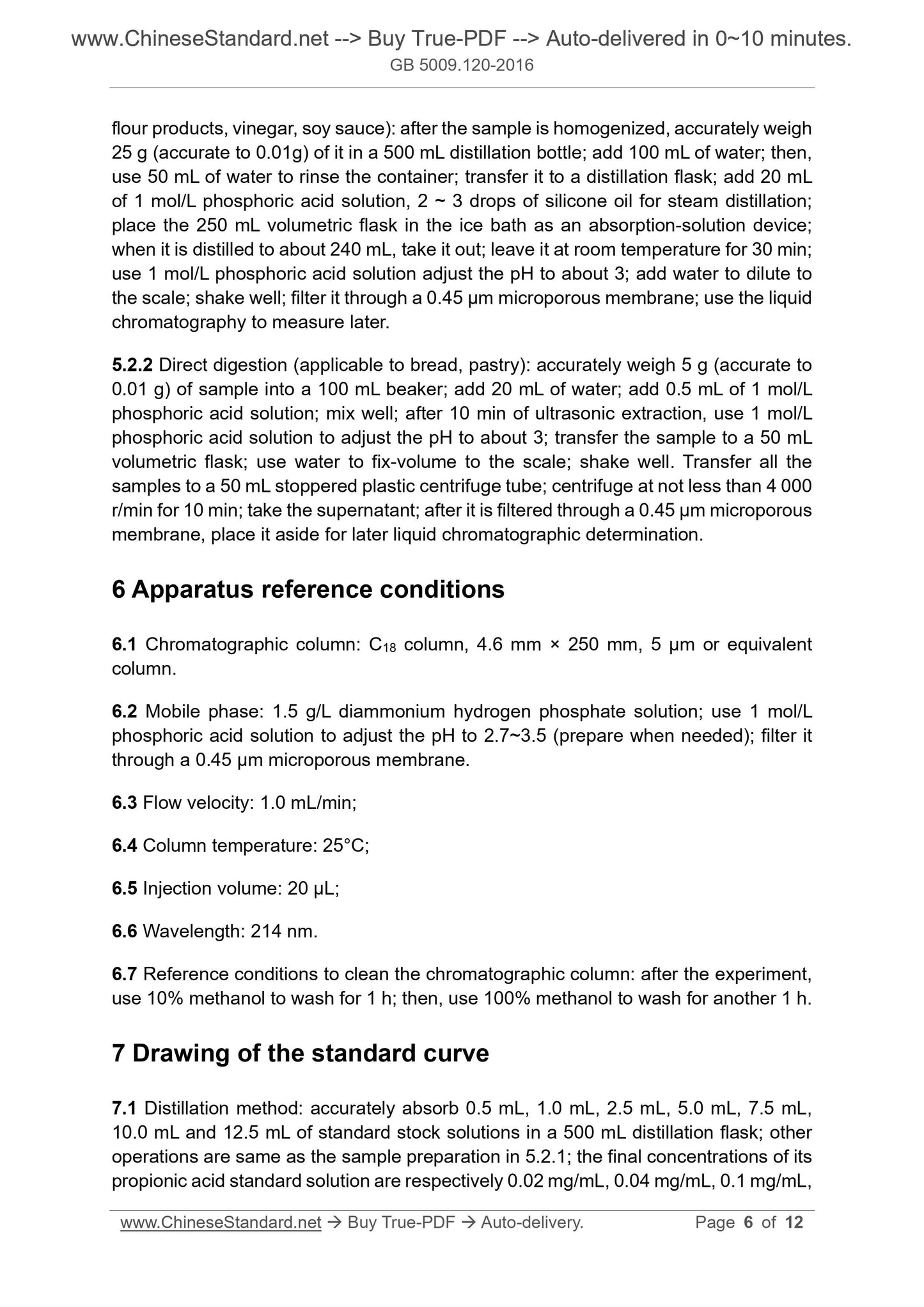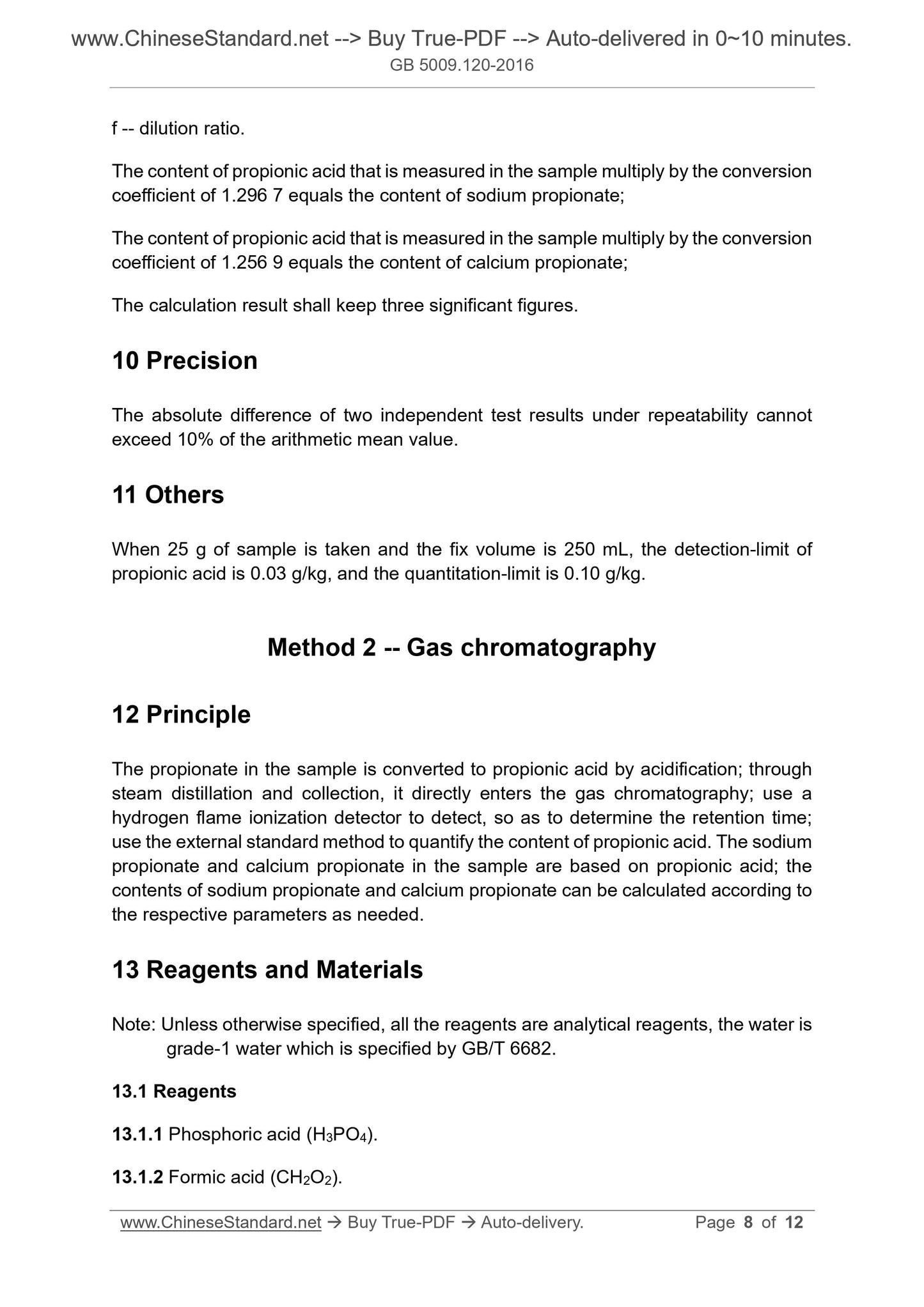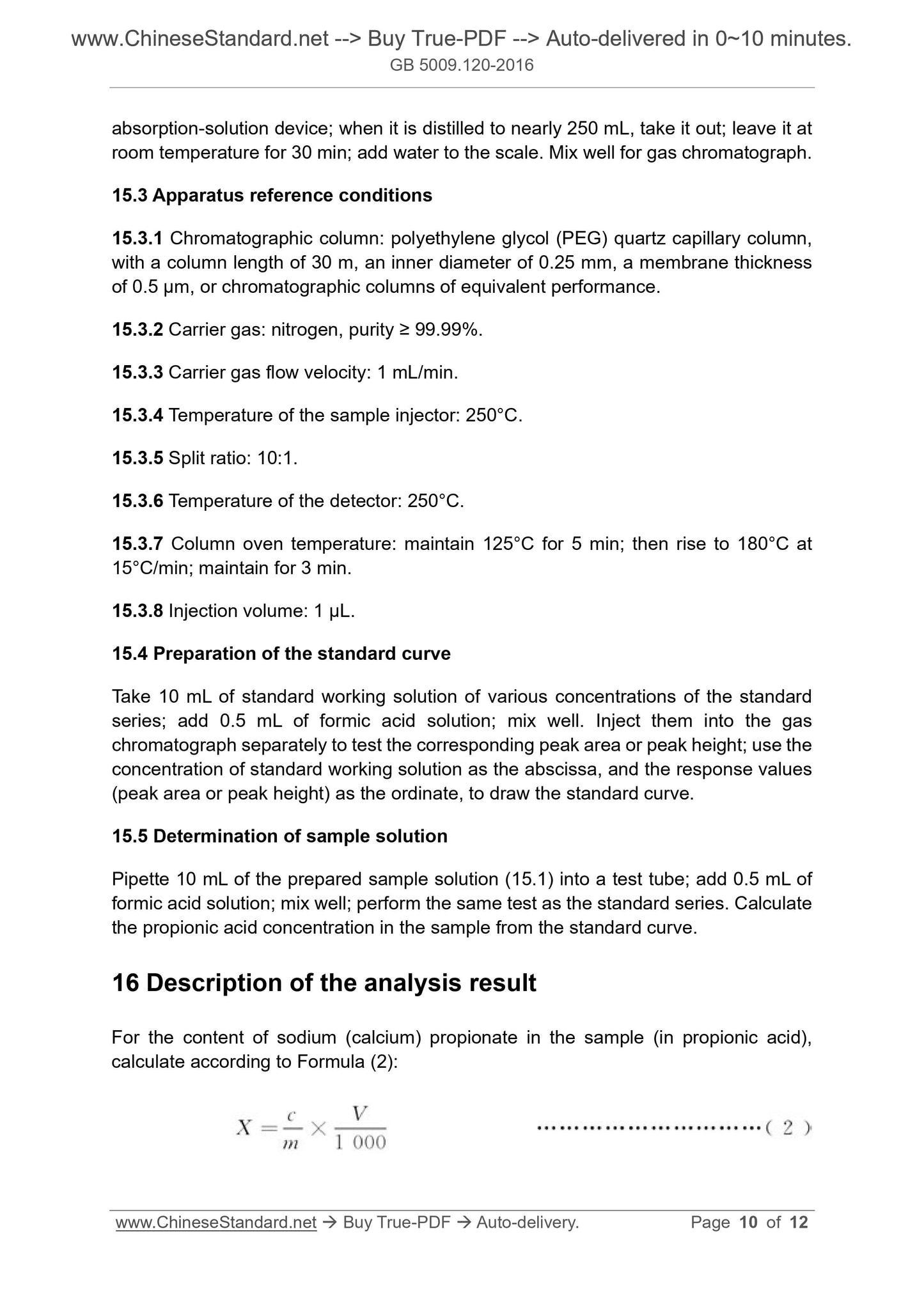1
/
of
6
www.ChineseStandard.us -- Field Test Asia Pte. Ltd.
GB 5009.120-2016 English PDF
GB 5009.120-2016 English PDF
Regular price
$90.00
Regular price
Sale price
$90.00
Unit price
/
per
Shipping calculated at checkout.
Couldn't load pickup availability
GB 5009.120-2016: National food safety standard - Determination of Sodium Propionate and Calcium Propionate in Foods
Delivery: 9 seconds. Download (& Email) true-PDF + Invoice.
Get Quotation: Click GB 5009.120-2016 (Self-service in 1-minute)
Historical versions (Master-website): GB 5009.120-2016
Preview True-PDF (Reload/Scroll-down if blank)
GB 5009.120-2016
NATIONAL STANDARD OF THE
PEOPLE’S REPUBLIC OF CHINA
National Food Safety Standard - Determination of Sodium
Propionate and Calcium Propionate in Foods
ISSUED ON: AUGUST 31, 2016
IMPLEMENTED ON: MARCH 01, 2017
Issued by: National Health and Family Planning Commission of the PRC
Table of Contents
Foreword ... 3
1 Scope ... 4
2 Principle ... 4
3 Reagents and materials ... 4
4 Instruments and apparatuses ... 5
5 Analysis steps ... 5
6 Apparatus reference conditions ... 6
7 Drawing of the standard curve ... 6
8 Determination of sample solution ... 7
9 Description of the analysis result ... 7
10 Precision ... 8
11 Others ... 8
12 Principle ... 8
13 Reagents and Materials ... 8
14 Instruments and apparatuses ... 9
15 Analysis steps ... 9
16 Description of the analysis result ... 10
17 Precision ... 11
18 Others ... 11
Appendix A Standard substance chromatogram ... 12
National Food Safety Standard - Determination of Sodium
Propionate and Calcium Propionate in Foods
1 Scope
This Standard specifies the determination methods of sodium propionate and calcium
propionate in bean products, raw and moist flour products, bread, cakes, vinegar and
soy sauce.
This Standard applies to the determination of sodium propionate and calcium
propionate in bean products, raw and moist flour products, bread, cakes, vinegar and
soy sauce.
Method 1 -- Liquid Chromatography
2 Principle
The propionate in the sample, through acidification, is converted into propionic acid;
then, it is extracted by ultrasonic water bath or distilled by steam distilled; it is collected
and adjusted in pH; it is determined by high performance liquid chromatography; and,
the content of propionic acid is quantified by external standard method. The sodium
propionate and calcium propionate in the sample are based on propionic acid; the
contents of sodium propionate and calcium propionate can be calculated according to
the respective parameters as needed.
3 Reagents and materials
Unless otherwise specified, all the reagents are analytical reagents, the water is grade-
1 water which is specified by GB/T 6682.
3.1 Reagents
3.1.1 Phosphoric acid (H3PO4).
3.1.2 Diammonium hydrogen phosphate [(NH4)2HPO4].
3.1.3 Silicone oil.
3.2 Preparation of reagents
flour products, vinegar, soy sauce): after the sample is homogenized, accurately weigh
25 g (accurate to 0.01g) of it in a 500 mL distillation bottle; add 100 mL of water; then,
use 50 mL of water to rinse the container; transfer it to a distillation flask; add 20 mL
of 1 mol/L phosphoric acid solution, 2 ~ 3 drops of silicone oil for steam distillation;
place the 250 mL volumetric flask in the ice bath as an absorption-solution device;
when it is distilled to about 240 mL, take it out; leave it at room temperature for 30 min;
use 1 mol/L phosphoric acid solution adjust the pH to about 3; add water to dilute to
the scale; shake well; filter it through a 0.45 μm microporous membrane; use the liquid
chromatography to measure later.
5.2.2 Direct digestion (applicable to bread, pastry): accurately weigh 5 g (accurate to
0.01 g) of sample into a 100 mL beaker; add 20 mL of water; add 0.5 mL of 1 mol/L
phosphoric acid solution; mix well; after 10 min of ultrasonic extraction, use 1 mol/L
phosphoric acid solution to adjust the pH to about 3; transfer the sample to a 50 mL
volumetric flask; use water to fix-volume to the scale; shake well. Transfer all the
samples to a 50 mL stoppered plastic centrifuge tube; centrifuge at not less than 4 000
r/min for 10 min; take the supernatant; after it is filtered through a 0.45 μm microporous
membrane, place it aside for later liquid chromatographic determination.
6 Apparatus reference conditions
6.1 Chromatographic column: C18 column, 4.6 mm × 250 mm, 5 μm or equivalent
column.
6.2 Mobile phase: 1.5 g/L diammonium hydrogen phosphate solution; use 1 mol/L
phosphoric acid solution to adjust the pH to 2.7~3.5 (prepare when needed); filter it
through a 0.45 μm microporous membrane.
6.3 Flow velocity: 1.0 mL/min;
6.4 Column temperature: 25°C;
6.5 Injection volume: 20 μL;
6.6 Wavelength: 214 nm.
6.7 Reference conditions to clean the chromatographic column: after the experiment,
use 10% methanol to wash for 1 h; then, use 100% methanol to wash for another 1 h.
7 Drawing of the standard curve
7.1 Distillation method: accurately absorb 0.5 mL, 1.0 mL, 2.5 mL, 5.0 mL, 7.5 mL,
10.0 mL and 12.5 mL of standard stock solutions in a 500 mL distillation flask; other
operations are same as the sample preparation in 5.2.1; the final concentrations of its
propionic acid standard solution are respectively 0.02 mg/mL, 0.04 mg/mL, 0.1 mg/mL,
f -- dilution ratio.
The content of propionic acid that is measured in the sample multiply by the conversion
coefficient of 1.296 7 equals the content of sodium propionate;
The content of propionic acid that is measured in the sample multiply by the conversion
coefficient of 1.256 9 equals the content of calcium propionate;
The calculation result shall keep three significant figures.
10 Precision
The absolute difference of two independent test results under repeatability cannot
exceed 10% of the arithmetic mean value.
11 Others
When 25 g of sample is taken and the fix volume is 250 mL, the detection-limit of
propionic acid is 0.03 g/kg, and the quantitation-limit is 0.10 g/kg.
Method 2 -- Gas chromatography
12 Principle
The propionate in the sample is converted to propionic acid by acidification; through
steam distillation and collection, it directly enters the gas chromatography; use a
hydrogen flame ionization detector to detect, so as to determine the retention time;
use the external standard method to quantify the content of propionic acid. The sodium
propionate and calcium propionate in the sample are based on propionic acid; the
contents of sodium propionate and calcium propionate can be calculated according to
the respective parameters as needed.
13 Reagents and Materials
Note: Unless otherwise specified, all the reagents are analytical reagents, the water is
grade-1 water which is specified by GB/T 6682.
13.1 Reagents
13.1.1 Phosphoric acid (H3PO4).
13.1.2 Formic acid (CH2O2).
absorption-solution device; when it is distilled to nearly 250 mL, take it out; leave it at
room temperature for 30 min; add water to the scale. Mix well for gas chromatograph.
15.3 Apparatus reference conditions
15.3.1 Chromatographic column: polyethylene glycol (PEG) quartz capillary column,
with a column length of 30 m, an inner diameter of 0.25 mm, a membrane thickness
of 0.5 μm, or chromatographic columns of equivalent performance.
15.3.2 Carrier gas: nitrogen, purity ≥ 99.99%.
15.3.3 Carrier gas flow velocity: 1 mL/min.
15.3.4 Temperature of the sample injector: 250°C.
15.3.5 Split ratio: 10:1.
15.3.6 Temperature of the detector: 250°C.
15.3.7 Column oven temperature: maintain 125°C for 5 min; then rise to 180°C at
15°C/min; maintain for 3 min.
15.3.8 Injection volume: 1 μL.
15.4 Preparation of the standard curve
Take 10 mL of standard working solution of various concentrations of the standard
series; add 0.5 mL of formic acid solution; mix well. Inject them into the gas
chromatograph separately to test the corresponding peak area or peak height; use the
concentration of standard working solution as the abscissa, and the response values
(peak area or peak height) as the ordinate, to draw the standard curve.
15.5 Determination of sample solution
Pipette 10 mL of the prepared sample solution (15.1) into a test tube; add 0.5 mL of
formic acid solution; mix well; perform the same test as the standard series. Calculate
the propionic acid concentration in the sample from the standard curve.
16 Description of the analysis result
For the content of sodium (calcium) propionate in the sample (in propionic acid),
calculate according to Formula (2):
GB 5009.120-2016
NATIONAL STANDARD OF THE
PEOPLE’S REPUBLIC OF CHINA
National Food Safety Standard - Determination of Sodium
Propionate and Calcium Propionate in Foods
ISSUED ON: AUGUST 31, 2016
IMPLEMENTED ON: MARCH 01, 2017
Issued by: National Health and Family Planning Commission of the PRC
Table of Contents
Foreword ... 3
1 Scope ... 4
2 Principle ... 4
3 Reagents and materials ... 4
4 Instruments and apparatuses ... 5
5 Analysis steps ... 5
6 Apparatus reference conditions ... 6
7 Drawing of the standard curve ... 6
8 Determination of sample solution ... 7
9 Description of the analysis result ... 7
10 Precision ... 8
11 Others ... 8
12 Principle ... 8
13 Reagents and Materials ... 8
14 Instruments and apparatuses ... 9
15 Analysis steps ... 9
16 Description of the analysis result ... 10
17 Precision ... 11
18 Others ... 11
Appendix A Standard substance chromatogram ... 12
National Food Safety Standard - Determination of Sodium
Propionate and Calcium Propionate in Foods
1 Scope
This Standard specifies the determination methods of sodium propionate and calcium
propionate in bean products, raw and moist flour products, bread, cakes, vinegar and
soy sauce.
This Standard applies to the determination of sodium propionate and calcium
propionate in bean products, raw and moist flour products, bread, cakes, vinegar and
soy sauce.
Method 1 -- Liquid Chromatography
2 Principle
The propionate in the sample, through acidification, is converted into propionic acid;
then, it is extracted by ultrasonic water bath or distilled by steam distilled; it is collected
and adjusted in pH; it is determined by high performance liquid chromatography; and,
the content of propionic acid is quantified by external standard method. The sodium
propionate and calcium propionate in the sample are based on propionic acid; the
contents of sodium propionate and calcium propionate can be calculated according to
the respective parameters as needed.
3 Reagents and materials
Unless otherwise specified, all the reagents are analytical reagents, the water is grade-
1 water which is specified by GB/T 6682.
3.1 Reagents
3.1.1 Phosphoric acid (H3PO4).
3.1.2 Diammonium hydrogen phosphate [(NH4)2HPO4].
3.1.3 Silicone oil.
3.2 Preparation of reagents
flour products, vinegar, soy sauce): after the sample is homogenized, accurately weigh
25 g (accurate to 0.01g) of it in a 500 mL distillation bottle; add 100 mL of water; then,
use 50 mL of water to rinse the container; transfer it to a distillation flask; add 20 mL
of 1 mol/L phosphoric acid solution, 2 ~ 3 drops of silicone oil for steam distillation;
place the 250 mL volumetric flask in the ice bath as an absorption-solution device;
when it is distilled to about 240 mL, take it out; leave it at room temperature for 30 min;
use 1 mol/L phosphoric acid solution adjust the pH to about 3; add water to dilute to
the scale; shake well; filter it through a 0.45 μm microporous membrane; use the liquid
chromatography to measure later.
5.2.2 Direct digestion (applicable to bread, pastry): accurately weigh 5 g (accurate to
0.01 g) of sample into a 100 mL beaker; add 20 mL of water; add 0.5 mL of 1 mol/L
phosphoric acid solution; mix well; after 10 min of ultrasonic extraction, use 1 mol/L
phosphoric acid solution to adjust the pH to about 3; transfer the sample to a 50 mL
volumetric flask; use water to fix-volume to the scale; shake well. Transfer all the
samples to a 50 mL stoppered plastic centrifuge tube; centrifuge at not less than 4 000
r/min for 10 min; take the supernatant; after it is filtered through a 0.45 μm microporous
membrane, place it aside for later liquid chromatographic determination.
6 Apparatus reference conditions
6.1 Chromatographic column: C18 column, 4.6 mm × 250 mm, 5 μm or equivalent
column.
6.2 Mobile phase: 1.5 g/L diammonium hydrogen phosphate solution; use 1 mol/L
phosphoric acid solution to adjust the pH to 2.7~3.5 (prepare when needed); filter it
through a 0.45 μm microporous membrane.
6.3 Flow velocity: 1.0 mL/min;
6.4 Column temperature: 25°C;
6.5 Injection volume: 20 μL;
6.6 Wavelength: 214 nm.
6.7 Reference conditions to clean the chromatographic column: after the experiment,
use 10% methanol to wash for 1 h; then, use 100% methanol to wash for another 1 h.
7 Drawing of the standard curve
7.1 Distillation method: accurately absorb 0.5 mL, 1.0 mL, 2.5 mL, 5.0 mL, 7.5 mL,
10.0 mL and 12.5 mL of standard stock solutions in a 500 mL distillation flask; other
operations are same as the sample preparation in 5.2.1; the final concentrations of its
propionic acid standard solution are respectively 0.02 mg/mL, 0.04 mg/mL, 0.1 mg/mL,
f -- dilution ratio.
The content of propionic acid that is measured in the sample multiply by the conversion
coefficient of 1.296 7 equals the content of sodium propionate;
The content of propionic acid that is measured in the sample multiply by the conversion
coefficient of 1.256 9 equals the content of calcium propionate;
The calculation result shall keep three significant figures.
10 Precision
The absolute difference of two independent test results under repeatability cannot
exceed 10% of the arithmetic mean value.
11 Others
When 25 g of sample is taken and the fix volume is 250 mL, the detection-limit of
propionic acid is 0.03 g/kg, and the quantitation-limit is 0.10 g/kg.
Method 2 -- Gas chromatography
12 Principle
The propionate in the sample is converted to propionic acid by acidification; through
steam distillation and collection, it directly enters the gas chromatography; use a
hydrogen flame ionization detector to detect, so as to determine the retention time;
use the external standard method to quantify the content of propionic acid. The sodium
propionate and calcium propionate in the sample are based on propionic acid; the
contents of sodium propionate and calcium propionate can be calculated according to
the respective parameters as needed. <...
Delivery: 9 seconds. Download (& Email) true-PDF + Invoice.
Get Quotation: Click GB 5009.120-2016 (Self-service in 1-minute)
Historical versions (Master-website): GB 5009.120-2016
Preview True-PDF (Reload/Scroll-down if blank)
GB 5009.120-2016
NATIONAL STANDARD OF THE
PEOPLE’S REPUBLIC OF CHINA
National Food Safety Standard - Determination of Sodium
Propionate and Calcium Propionate in Foods
ISSUED ON: AUGUST 31, 2016
IMPLEMENTED ON: MARCH 01, 2017
Issued by: National Health and Family Planning Commission of the PRC
Table of Contents
Foreword ... 3
1 Scope ... 4
2 Principle ... 4
3 Reagents and materials ... 4
4 Instruments and apparatuses ... 5
5 Analysis steps ... 5
6 Apparatus reference conditions ... 6
7 Drawing of the standard curve ... 6
8 Determination of sample solution ... 7
9 Description of the analysis result ... 7
10 Precision ... 8
11 Others ... 8
12 Principle ... 8
13 Reagents and Materials ... 8
14 Instruments and apparatuses ... 9
15 Analysis steps ... 9
16 Description of the analysis result ... 10
17 Precision ... 11
18 Others ... 11
Appendix A Standard substance chromatogram ... 12
National Food Safety Standard - Determination of Sodium
Propionate and Calcium Propionate in Foods
1 Scope
This Standard specifies the determination methods of sodium propionate and calcium
propionate in bean products, raw and moist flour products, bread, cakes, vinegar and
soy sauce.
This Standard applies to the determination of sodium propionate and calcium
propionate in bean products, raw and moist flour products, bread, cakes, vinegar and
soy sauce.
Method 1 -- Liquid Chromatography
2 Principle
The propionate in the sample, through acidification, is converted into propionic acid;
then, it is extracted by ultrasonic water bath or distilled by steam distilled; it is collected
and adjusted in pH; it is determined by high performance liquid chromatography; and,
the content of propionic acid is quantified by external standard method. The sodium
propionate and calcium propionate in the sample are based on propionic acid; the
contents of sodium propionate and calcium propionate can be calculated according to
the respective parameters as needed.
3 Reagents and materials
Unless otherwise specified, all the reagents are analytical reagents, the water is grade-
1 water which is specified by GB/T 6682.
3.1 Reagents
3.1.1 Phosphoric acid (H3PO4).
3.1.2 Diammonium hydrogen phosphate [(NH4)2HPO4].
3.1.3 Silicone oil.
3.2 Preparation of reagents
flour products, vinegar, soy sauce): after the sample is homogenized, accurately weigh
25 g (accurate to 0.01g) of it in a 500 mL distillation bottle; add 100 mL of water; then,
use 50 mL of water to rinse the container; transfer it to a distillation flask; add 20 mL
of 1 mol/L phosphoric acid solution, 2 ~ 3 drops of silicone oil for steam distillation;
place the 250 mL volumetric flask in the ice bath as an absorption-solution device;
when it is distilled to about 240 mL, take it out; leave it at room temperature for 30 min;
use 1 mol/L phosphoric acid solution adjust the pH to about 3; add water to dilute to
the scale; shake well; filter it through a 0.45 μm microporous membrane; use the liquid
chromatography to measure later.
5.2.2 Direct digestion (applicable to bread, pastry): accurately weigh 5 g (accurate to
0.01 g) of sample into a 100 mL beaker; add 20 mL of water; add 0.5 mL of 1 mol/L
phosphoric acid solution; mix well; after 10 min of ultrasonic extraction, use 1 mol/L
phosphoric acid solution to adjust the pH to about 3; transfer the sample to a 50 mL
volumetric flask; use water to fix-volume to the scale; shake well. Transfer all the
samples to a 50 mL stoppered plastic centrifuge tube; centrifuge at not less than 4 000
r/min for 10 min; take the supernatant; after it is filtered through a 0.45 μm microporous
membrane, place it aside for later liquid chromatographic determination.
6 Apparatus reference conditions
6.1 Chromatographic column: C18 column, 4.6 mm × 250 mm, 5 μm or equivalent
column.
6.2 Mobile phase: 1.5 g/L diammonium hydrogen phosphate solution; use 1 mol/L
phosphoric acid solution to adjust the pH to 2.7~3.5 (prepare when needed); filter it
through a 0.45 μm microporous membrane.
6.3 Flow velocity: 1.0 mL/min;
6.4 Column temperature: 25°C;
6.5 Injection volume: 20 μL;
6.6 Wavelength: 214 nm.
6.7 Reference conditions to clean the chromatographic column: after the experiment,
use 10% methanol to wash for 1 h; then, use 100% methanol to wash for another 1 h.
7 Drawing of the standard curve
7.1 Distillation method: accurately absorb 0.5 mL, 1.0 mL, 2.5 mL, 5.0 mL, 7.5 mL,
10.0 mL and 12.5 mL of standard stock solutions in a 500 mL distillation flask; other
operations are same as the sample preparation in 5.2.1; the final concentrations of its
propionic acid standard solution are respectively 0.02 mg/mL, 0.04 mg/mL, 0.1 mg/mL,
f -- dilution ratio.
The content of propionic acid that is measured in the sample multiply by the conversion
coefficient of 1.296 7 equals the content of sodium propionate;
The content of propionic acid that is measured in the sample multiply by the conversion
coefficient of 1.256 9 equals the content of calcium propionate;
The calculation result shall keep three significant figures.
10 Precision
The absolute difference of two independent test results under repeatability cannot
exceed 10% of the arithmetic mean value.
11 Others
When 25 g of sample is taken and the fix volume is 250 mL, the detection-limit of
propionic acid is 0.03 g/kg, and the quantitation-limit is 0.10 g/kg.
Method 2 -- Gas chromatography
12 Principle
The propionate in the sample is converted to propionic acid by acidification; through
steam distillation and collection, it directly enters the gas chromatography; use a
hydrogen flame ionization detector to detect, so as to determine the retention time;
use the external standard method to quantify the content of propionic acid. The sodium
propionate and calcium propionate in the sample are based on propionic acid; the
contents of sodium propionate and calcium propionate can be calculated according to
the respective parameters as needed.
13 Reagents and Materials
Note: Unless otherwise specified, all the reagents are analytical reagents, the water is
grade-1 water which is specified by GB/T 6682.
13.1 Reagents
13.1.1 Phosphoric acid (H3PO4).
13.1.2 Formic acid (CH2O2).
absorption-solution device; when it is distilled to nearly 250 mL, take it out; leave it at
room temperature for 30 min; add water to the scale. Mix well for gas chromatograph.
15.3 Apparatus reference conditions
15.3.1 Chromatographic column: polyethylene glycol (PEG) quartz capillary column,
with a column length of 30 m, an inner diameter of 0.25 mm, a membrane thickness
of 0.5 μm, or chromatographic columns of equivalent performance.
15.3.2 Carrier gas: nitrogen, purity ≥ 99.99%.
15.3.3 Carrier gas flow velocity: 1 mL/min.
15.3.4 Temperature of the sample injector: 250°C.
15.3.5 Split ratio: 10:1.
15.3.6 Temperature of the detector: 250°C.
15.3.7 Column oven temperature: maintain 125°C for 5 min; then rise to 180°C at
15°C/min; maintain for 3 min.
15.3.8 Injection volume: 1 μL.
15.4 Preparation of the standard curve
Take 10 mL of standard working solution of various concentrations of the standard
series; add 0.5 mL of formic acid solution; mix well. Inject them into the gas
chromatograph separately to test the corresponding peak area or peak height; use the
concentration of standard working solution as the abscissa, and the response values
(peak area or peak height) as the ordinate, to draw the standard curve.
15.5 Determination of sample solution
Pipette 10 mL of the prepared sample solution (15.1) into a test tube; add 0.5 mL of
formic acid solution; mix well; perform the same test as the standard series. Calculate
the propionic acid concentration in the sample from the standard curve.
16 Description of the analysis result
For the content of sodium (calcium) propionate in the sample (in propionic acid),
calculate according to Formula (2):
GB 5009.120-2016
NATIONAL STANDARD OF THE
PEOPLE’S REPUBLIC OF CHINA
National Food Safety Standard - Determination of Sodium
Propionate and Calcium Propionate in Foods
ISSUED ON: AUGUST 31, 2016
IMPLEMENTED ON: MARCH 01, 2017
Issued by: National Health and Family Planning Commission of the PRC
Table of Contents
Foreword ... 3
1 Scope ... 4
2 Principle ... 4
3 Reagents and materials ... 4
4 Instruments and apparatuses ... 5
5 Analysis steps ... 5
6 Apparatus reference conditions ... 6
7 Drawing of the standard curve ... 6
8 Determination of sample solution ... 7
9 Description of the analysis result ... 7
10 Precision ... 8
11 Others ... 8
12 Principle ... 8
13 Reagents and Materials ... 8
14 Instruments and apparatuses ... 9
15 Analysis steps ... 9
16 Description of the analysis result ... 10
17 Precision ... 11
18 Others ... 11
Appendix A Standard substance chromatogram ... 12
National Food Safety Standard - Determination of Sodium
Propionate and Calcium Propionate in Foods
1 Scope
This Standard specifies the determination methods of sodium propionate and calcium
propionate in bean products, raw and moist flour products, bread, cakes, vinegar and
soy sauce.
This Standard applies to the determination of sodium propionate and calcium
propionate in bean products, raw and moist flour products, bread, cakes, vinegar and
soy sauce.
Method 1 -- Liquid Chromatography
2 Principle
The propionate in the sample, through acidification, is converted into propionic acid;
then, it is extracted by ultrasonic water bath or distilled by steam distilled; it is collected
and adjusted in pH; it is determined by high performance liquid chromatography; and,
the content of propionic acid is quantified by external standard method. The sodium
propionate and calcium propionate in the sample are based on propionic acid; the
contents of sodium propionate and calcium propionate can be calculated according to
the respective parameters as needed.
3 Reagents and materials
Unless otherwise specified, all the reagents are analytical reagents, the water is grade-
1 water which is specified by GB/T 6682.
3.1 Reagents
3.1.1 Phosphoric acid (H3PO4).
3.1.2 Diammonium hydrogen phosphate [(NH4)2HPO4].
3.1.3 Silicone oil.
3.2 Preparation of reagents
flour products, vinegar, soy sauce): after the sample is homogenized, accurately weigh
25 g (accurate to 0.01g) of it in a 500 mL distillation bottle; add 100 mL of water; then,
use 50 mL of water to rinse the container; transfer it to a distillation flask; add 20 mL
of 1 mol/L phosphoric acid solution, 2 ~ 3 drops of silicone oil for steam distillation;
place the 250 mL volumetric flask in the ice bath as an absorption-solution device;
when it is distilled to about 240 mL, take it out; leave it at room temperature for 30 min;
use 1 mol/L phosphoric acid solution adjust the pH to about 3; add water to dilute to
the scale; shake well; filter it through a 0.45 μm microporous membrane; use the liquid
chromatography to measure later.
5.2.2 Direct digestion (applicable to bread, pastry): accurately weigh 5 g (accurate to
0.01 g) of sample into a 100 mL beaker; add 20 mL of water; add 0.5 mL of 1 mol/L
phosphoric acid solution; mix well; after 10 min of ultrasonic extraction, use 1 mol/L
phosphoric acid solution to adjust the pH to about 3; transfer the sample to a 50 mL
volumetric flask; use water to fix-volume to the scale; shake well. Transfer all the
samples to a 50 mL stoppered plastic centrifuge tube; centrifuge at not less than 4 000
r/min for 10 min; take the supernatant; after it is filtered through a 0.45 μm microporous
membrane, place it aside for later liquid chromatographic determination.
6 Apparatus reference conditions
6.1 Chromatographic column: C18 column, 4.6 mm × 250 mm, 5 μm or equivalent
column.
6.2 Mobile phase: 1.5 g/L diammonium hydrogen phosphate solution; use 1 mol/L
phosphoric acid solution to adjust the pH to 2.7~3.5 (prepare when needed); filter it
through a 0.45 μm microporous membrane.
6.3 Flow velocity: 1.0 mL/min;
6.4 Column temperature: 25°C;
6.5 Injection volume: 20 μL;
6.6 Wavelength: 214 nm.
6.7 Reference conditions to clean the chromatographic column: after the experiment,
use 10% methanol to wash for 1 h; then, use 100% methanol to wash for another 1 h.
7 Drawing of the standard curve
7.1 Distillation method: accurately absorb 0.5 mL, 1.0 mL, 2.5 mL, 5.0 mL, 7.5 mL,
10.0 mL and 12.5 mL of standard stock solutions in a 500 mL distillation flask; other
operations are same as the sample preparation in 5.2.1; the final concentrations of its
propionic acid standard solution are respectively 0.02 mg/mL, 0.04 mg/mL, 0.1 mg/mL,
f -- dilution ratio.
The content of propionic acid that is measured in the sample multiply by the conversion
coefficient of 1.296 7 equals the content of sodium propionate;
The content of propionic acid that is measured in the sample multiply by the conversion
coefficient of 1.256 9 equals the content of calcium propionate;
The calculation result shall keep three significant figures.
10 Precision
The absolute difference of two independent test results under repeatability cannot
exceed 10% of the arithmetic mean value.
11 Others
When 25 g of sample is taken and the fix volume is 250 mL, the detection-limit of
propionic acid is 0.03 g/kg, and the quantitation-limit is 0.10 g/kg.
Method 2 -- Gas chromatography
12 Principle
The propionate in the sample is converted to propionic acid by acidification; through
steam distillation and collection, it directly enters the gas chromatography; use a
hydrogen flame ionization detector to detect, so as to determine the retention time;
use the external standard method to quantify the content of propionic acid. The sodium
propionate and calcium propionate in the sample are based on propionic acid; the
contents of sodium propionate and calcium propionate can be calculated according to
the respective parameters as needed. <...
Share
